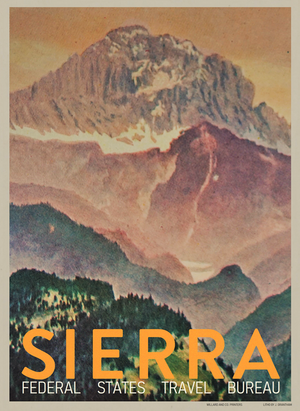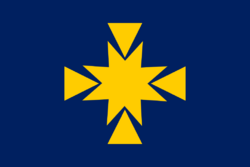Main Page/FeaturedArticle
Featured Wiki Articles (Archive) |
|---|
2021-05-02 |
|
The State of Sierra (Castellanese: Estado de Sierra) is a state is the western Federal States. It is one of the largest states in terms of area, but more sparsely populated. The state is known for its landscape consisting of the Sierras, wide, open high plains and plateaus, desert areas and rivers. It borders Tauhon in the west, Clamash to the south, Riopoderos and to the southeast, Apawiland. Sierra was first settled around the year 800, had vibrant Native Archantan cultures, settlements and even some cities by 1000-1200. Sierra was explored by the Castellanese from around 1530, though primarily from 1650 onward. The first settlements sprang up around the rivers, primarily in the west. Sierra became a possession of the FSA from 1841, and a territory in 1858. Statehood was achieved in April 1872.
More . . .
|
2020-12-06 and 2015-02-28 |
File:Road-698628 640.jpg National Route 35 in Neredge Mountains National Park Belphenia (officially the Theocratic People's Kingdom of Belphenia (TPKB; Nihonish:ベルフェニア) is a country in southeastern Uletha, consisting of 28 prefectures and 12 states. It is a theocracy, and shares land borders with Eurell to the north, Orinoco to the east, UL018c to the northwest, UL018g to the southwest, and with maritime borders with Pasundan-Padjadjaran to the south across the Sound of Pa, Commonia to the southeast across the Belphenian Sea, and UL018f to the west. Its capital city is Remiville. The name Belphenia is derived from the names Belphine and Beretania. This is a very rare name, and is very uncommon until Native Belphenians traveled to other countries and helped many people to recognize the name. Since 2011, Belphenia's official state religion is Great Heart. The religion that influenced Belphenia's expedition to find the truth about world events, which is why Belphenia is often referred to as "The Land of the Truth". The country is well known for establishing organizations known as Guilds, and is the major exporter of swords More . . .
|
2020-09-26 and 2017-07-15 |
File:Nahuwa-satellite.png Nahuwa Atoll viewed from space Nahuwa Atoll (Onnutuan: Nahuwa) is a possession of the Kingdom of Onnutu, located almost directly on the Equator, about 2500 km south of mainland Uletha and 2000 km south of the rest of Onnutu. The closest land is nearly 1000 km to the east. The atoll has a land area of just 14 square kilometers, surrounding a shallow lagoon of approximately 25 square kilometers. For centuries Nahuwa Atoll was known to seafaring peoples such as the Onnutuans (who called it Nahuvai in Old Uuvainese) and the Khaiwoonese (who called it Nakhoo). Archaeologists believe the atoll was used by these peoples only as a rest stop, as there is no evidence of any early settlement there. In 1790 the Ingerish landed and claimed the atoll, and in 1814 established the first permanent outpost, a small naval resupply station. Since 1983, the islands have been administered by the Kingdom of Onnutu. More . . .
|
2020-07-11 and 2017-12-4 and 2016-03-28 |
File:Khaiwoon Grand Prix 68.jpg 1968 Khaiwoon Grand Prix poster. The Khaiwoon Grand Prix is an auto racing event of the Open Geofiction Federation International of Autosports (OGFIA), held annually every March in the city-state of Khaiwoon. It is organized by both the Formula Plus (FP+) and Premier Formula (1PF) racing organizations, and features both FP+ and 1PF races. Tens of thousands of racing fans from all over the world attend the event every year. The racing takes place on a roughly triangular street circuit laid out in the Eastside area of the city, with Tacaikheeë Street on one side of the triangle, Eastside Avenue on another, and the Khagwai Transversale on the third. These streets are closed for several days in preparation for the race, as barriers are put up and other alterations are made for the racing vehicles. The course is slightly over three kilometers (two miles) in length and cars travel clockwise around the circuit. Large viewing stands are assembled alongside the course in Jopeeë Park as well as Kennedy Green to accommodate the demand for viewing. The racing is also visible from several hotels and other tall buildings in the area, and is broadcast by a number of sports television networks around the world. Extensive coverage of the Grand Prix is found in many local print publications, including the Times of Khaiwoon and others. More . . .
|
2020-06-06 and 2018-08-18 and 2017-05-01 |
File:Worldtravellerguidebook.png Myrcia travel guide The Socialist Republic of Myrcia (Myrcian: Folcyning Myrcia) is an island nation which is located in the the Hesperic Ocean (Myrcian: Lagufæsten) off the north-western coast of Uletha. It lies 60mi (110km) west of Scandmark and 80mi (140km) south-west of Ingerland. The country covers around 1,188 sq mi (3,079 km2) with a population of just under 1,000,000 people. The official language is Myrcian but Ingerish and Scandic are also widely spoken. The modern-day name Myrcia stems from the Myrcian language. The most common etymology states that the name comes from the words mærce (boundary / limit) and ria (island) as the island represented the last, major landmass before the wide Hesperic Ocean. Mercia, as an Ingerisation of the name, has fallen out of use since the Rihtwísness in the early 20th century. More . . .
|
2020-04-05 |
Exposition Gardens map is the largest park in Lake City. Dating back to 1891, the park was the site of the 1938 Global Exposition. Today, Exposition Gardens is home to the Lake City Zoo, the Lake City Public Market, the Randall Stephens Convention Center, and four of Lake City’s six professional sports teams. The park is generally bounded by the Lake City Union Railroad tracks to the north; 2nd Avenue to the west; Quincy Street to the south; and Trinity Avenue, North Street, and 10th Avenue to the east. The Lake City Zoo is located in the northwestern corner of Exposition Gardens, with the Randall Stephens Convention Center stretching across the middle of the park and the professional sporting facilities in the southern half of the park. The abandoned Exposition Transportation Building is located in the northeast corner of the park. Lake County General Hospital is located just east of Exposition Gardens. More . . .
|
2020-03-08 |
File:Lgdlogo.png LGD Logo Landstede Geleórednes Dunwic (LGD) (Ingerish: Dunwic Regional Transport (DRT)) is the primary operator of public transport services in Dunwic and Ceasternisc Bernica. Dunwic Burhcounsil owns 70% of LGD with the other 30% being divided between the other councils which make up Ceasternisc Bernica. The annual budget and policy direction of transport in the area is debated and passed by the Ceasternisc Counsil and LGD is ultimately accountable to them. When Dunwic Regional Transport was nationalised in 1994 it was purchased in its entirety by Dunwic Burhcounsil. Initially policy and governance decisions were made entirely by Dunwic government despite LGD's systems expanding across much of Ceasternisc Bernica. In 2000 30% of LGD was sold off to the eardcounsils which make up Ceasternisc Bernica and governance of LGD was moved from Dunwic's city government to the Ceasternisc Counsil which only meets twice a year but covers most of the metropolitan area. Currently the budget and major policy decisions are decided at the full counsil meetings and smaller decisions are ratified at weekly meetings of the Ceasternisc Counsil's transport committee. More . . .
|
2020-02-03 |
|
Vodeo is a country in central Tarephia. The nation consists of ten provinces while the capital and largest city is Saviso. Other major metropolitan areas include Holme, Gerrise, Avington, Silverton, and Welson. It is bordered by Serkan to the north, Denta to the south-west, Dania to the south, and the island nations of Promissão, Carpatia, and Ncadézaz to the east. The country's population of 33.8 million is mostly urbanised, with a majority of people living in the coastal cities. Various native tribes had inhabited equatorial Tarephia for thousands of years prior to Ulethan colonisation. Castellan was the first to colonise the area around the turn of the 16th century, followed by Rhysiogan settlers in 1594. In 1616, Ingerland took possession of New Cambria; over the following century it and its sister colony, St Austell became major producers of sugar, coffee, tea, tobacco, fruit, and cocoa. The two colonies became independent of Ingerland in 1725 and formed a confederation under the name of Equatorial Tarephia, however economic and political concerns saw the two merged into the Dominion of Vodeo on April 21, 1760 in a process known as Consolidation. From the mid-19th century, Vodeo became a major industrial power in Tarephia, and in the 20th century also became one of the world's most important centres of finance and technology. The country is a federal parliamentary democracy and a constitutional monarchy, with Queen Adelaide II as head of state and Victoria Stobie as Premier. More . . .
|
2020-01-03 and 2016-02-18 |
File:Karolian myths book cover.png The most well-known collection of Karolian mythology is Paavo Liipunen's Karolian Legends for Children, first published in 1907. This is a colour illustrated edition from 1929. The mythology of the area comprising modern Karolia dates back at least to the second century BC. Although there are many different versions of individual myths and characters throughout the country, all broadly feature the same stories, gods and human actors. The Kyori culture has its own myths in addition to the Karolian ones. The majority of myths extant today originate from the bardic tradition of the third to ninth centuries AD. The tales were written in poetic and prose forms and seem to have been performed as entertainment at gatherings and around shamanistic rituals. It appears that performances of certain tales were thought to facilitate contact with the ancestors and reveal hidden knowledge. The bards were thus highly respected in society and could expect to be given food and shelter in exchange for their performances. Knowledge of the stories and in particular how to accompany oneself on the harp was a closely guarded secret and would only be shared with apprentices. More . . .
|
Older Featured Articles |


